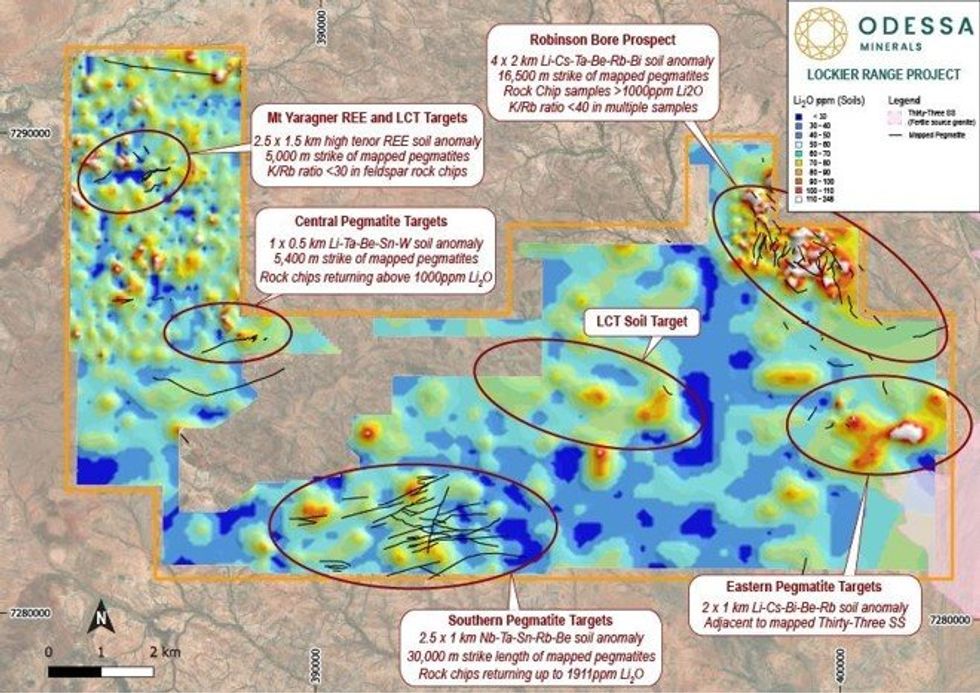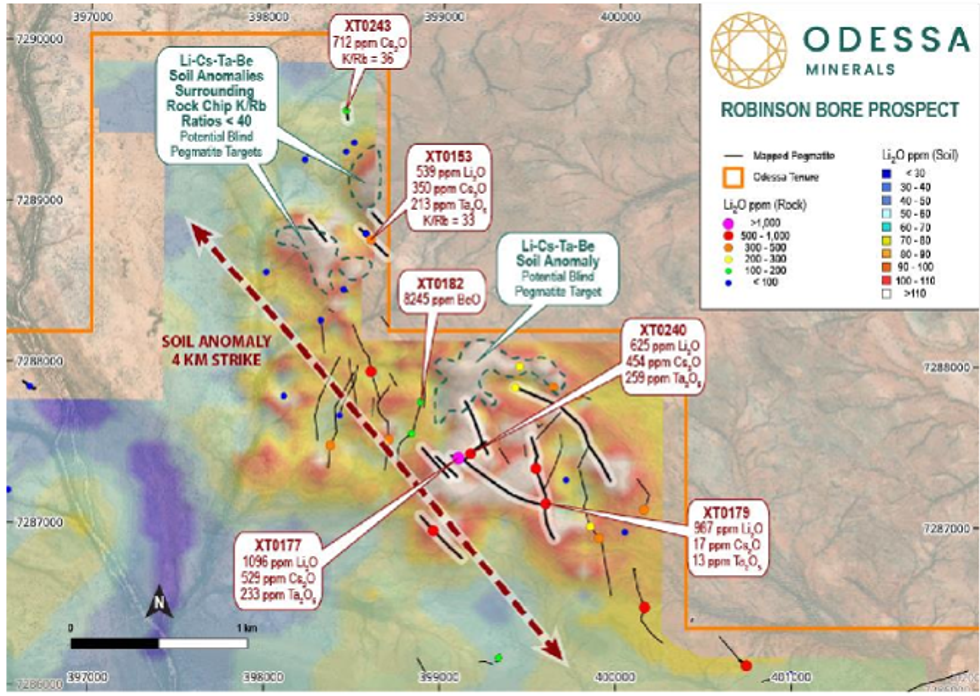
November 14, 2023
Yinnetharra Lockier Range Project
Odessa Minerals Limited (ASX:ODE) (“Odessa” or the “Company”) is pleased to provide a further update on the exploration program underway at its Yinnetharra Lithium Project at Lockier Range in the Gascoyne region of Western Australia.
Highlights:
- Assay results (Rock chip and soils) define standout DRILLING TARGETS for Lithium in Pegmatites
- Soil sampling defines coherent anomalous lithium-pegmatite trends:
- 248 soil samples return Li2O > 100 ppm
- 4km x 2km northwest-trending Li-Cs-Ta-Be-Rb-Bi anomaly at Robinson Bore coincident to the 16,500m of sub-cropping fractionated pegmatites
- 2.7km x 2km coherent Li-Cs-Ta-Be anomaly at the Eastern Pegmatite Field adjacent to the fertile Thirty Three Supersuite granite
- Highly-elevated key lithium-pegmatite pathfinders in rock chips including:
- peak Li2O result of 1911ppm
- 22 samples above 500ppm Li2O
- 5 samples above 100ppm Ta2O5 (Peak 259ppm)
- 18 samples above 100ppm Cs2O (Peak 712ppm)
- 9 samples above 100ppm BeO (Peak 8245ppm)
- 7 samples above 2000ppm Rb (Peak 2728ppm)
- Pegmatite Rock chip samples at Mt Yaragner show a westward fractionation trend with K/Rb ratios within feldspars <30
David Lenigas, Executive Director of Odessa, said: “Odessa’s exploration team have processed thousands of rock chip and soil samples from Lockier Range over the past 6 months and the results have now defined some exceptional lithium rich areas that will be targeted with our maiden drilling programme. The Company is actively engaging with Native Title Holders to complete the necessary access permissions so that we can get the drills turning on the ground. We have excellent targets to drill at four locations, with a number of key indicators pointing to existence of extensive LCT systems, and drilling is the next phase of exploration planned here. At Robinson Bore alone, for example, we have identified a lithium trend of 4km that needs to be drilled.”
Lockier Range Lithium Pegmatite Targets
In addition to the Robinson Bore rock chip results announced to the market on 16th October 2023, all rock chip and soil samples across the Yinnetharra Lockier Range Project have been received, with analysis of LCT pegmatite results now completed (Figure 1).
Recent rock chip sampling aimed to identify highly fractionated and fertile pegmatites across the Lockier Range Project through feldspar and mica multi-element analysis, as well as whole-rock pegmatite analysis. Recent soil sampling aimed to identify anomalous trends indicative of potential blind, fertile pegmatites at Robinson Bore, the Eastern Pegmatite Field and Mt Yaragner.

Robinson Bore
The Company has successfully identified a coherent 4km x 2km northwest-trending Li-Cs-Ta-Be-Rb-Bi in-soil anomaly at Robinson Bore, coincident with the recently announced 2.5km-long northwest-trending corridor of fractionated pegmatites (Figure 2). A total of 140 soil samples returned Li2O results above 100ppm at Robinson Bore, mirroring the trend of sub-cropping mapped pegmatites.
The majority of pegmatites at Robinson Bore occur in sub-crop, with vast areas concealed by cover material. The in-soil anomalies have generated additional targets where potential blind pegmatites are present, notably along the fractionation trend (Figure 2).

Eastern Pegmatite Field
The Eastern Pegmatite Field is located directly adjacent to the fertile Thirty Three Supersuite granite that is thought to be the source of lithium-bearing pegmatites at Delta Lithium’s Yinnetharra Project. Soil Sample results at the Eastern pegmatite Field have returned a coherent 2.7km x 2km Li-Cs-Ta-Be anomaly, with 61 soil samples above 100ppm Li2O (Figure 3). No outcropping pegmatites were found, with the in-soil anomaly generating targets for potential blind pegmatites.
A significant northwest trend in Sn-W-Bi pegmatite pathfinders extends from the mapped margin of the fertile Thirty Three Supersuite granite from the Eastern Pegmatite Field soil anomaly through to the sub-cropping Robinson Bore Pegmatite Field (Figure 3).
Click here for the full ASX Release
This article includes content from Odessa Minerals, licensed for the purpose of publishing on Investing News Australia. This article does not constitute financial product advice. It is your responsibility to perform proper due diligence before acting upon any information provided here. Please refer to our full disclaimer here.
ODE:AU
The Conversation (0)
11 October 2023
Odessa Minerals
Uranium exploration in the Gascoyne Region of Western Australia
Uranium exploration in the Gascoyne Region of Western Australia Keep Reading...
Latest News
Interactive Chart
Latest Press Releases
Related News
TOP STOCKS
American Battery4.030.24
Aion Therapeutic0.10-0.01
Cybin Corp2.140.00
